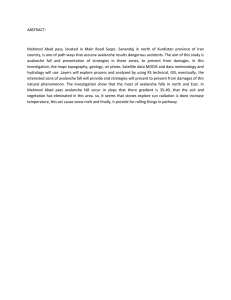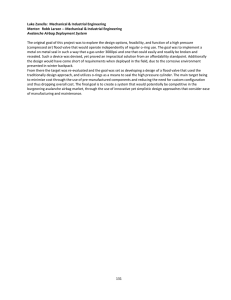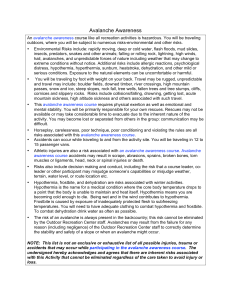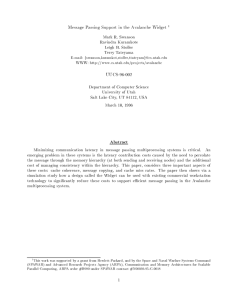A CASE STUDY IN AVALANCHE RISK TOLERANCE
advertisement
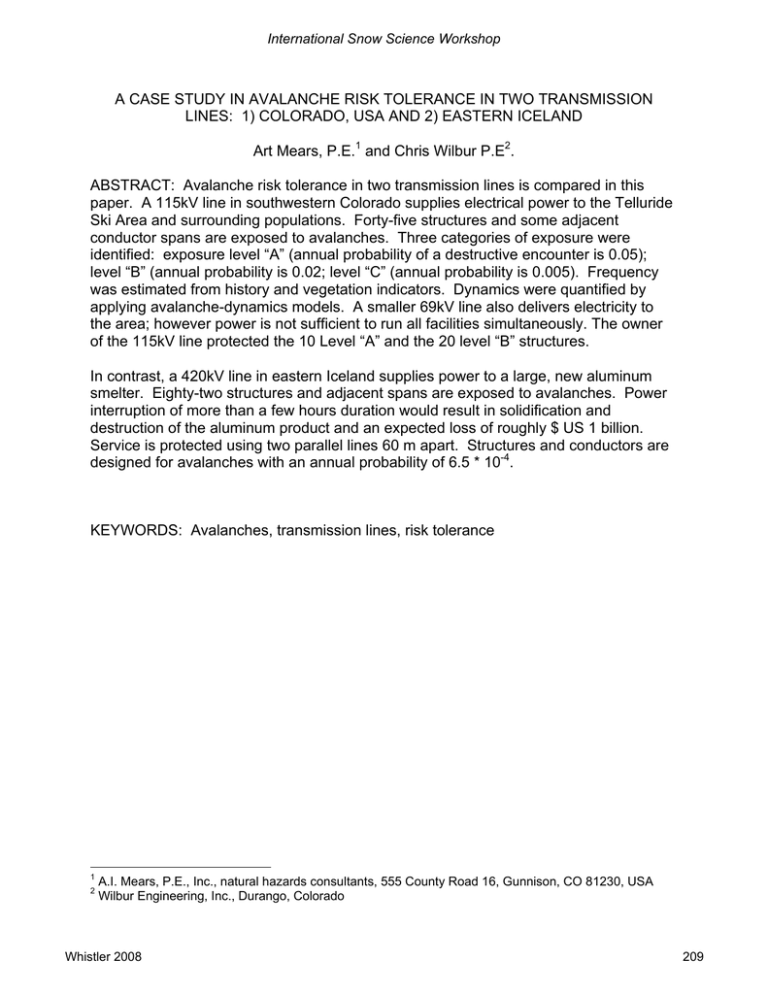
International Snow Science Workshop A CASE STUDY IN AVALANCHE RISK TOLERANCE IN TWO TRANSMISSION LINES: 1) COLORADO, USA AND 2) EASTERN ICELAND Art Mears, P.E.1 and Chris Wilbur P.E2. ABSTRACT: Avalanche risk tolerance in two transmission lines is compared in this paper. A 115kV line in southwestern Colorado supplies electrical power to the Telluride Ski Area and surrounding populations. Forty-five structures and some adjacent conductor spans are exposed to avalanches. Three categories of exposure were identified: exposure level “A” (annual probability of a destructive encounter is 0.05); level “B” (annual probability is 0.02; level “C” (annual probability is 0.005). Frequency was estimated from history and vegetation indicators. Dynamics were quantified by applying avalanche-dynamics models. A smaller 69kV line also delivers electricity to the area; however power is not sufficient to run all facilities simultaneously. The owner of the 115kV line protected the 10 Level “A” and the 20 level “B” structures. In contrast, a 420kV line in eastern Iceland supplies power to a large, new aluminum smelter. Eighty-two structures and adjacent spans are exposed to avalanches. Power interruption of more than a few hours duration would result in solidification and destruction of the aluminum product and an expected loss of roughly $ US 1 billion. Service is protected using two parallel lines 60 m apart. Structures and conductors are designed for avalanches with an annual probability of 6.5 * 10-4. KEYWORDS: Avalanches, transmission lines, risk tolerance 1 2 A.I. Mears, P.E., Inc., natural hazards consultants, 555 County Road 16, Gunnison, CO 81230, USA Wilbur Engineering, Inc., Durango, Colorado Whistler 2008 209 International Snow Science Workshop 1. INTRODUCTION – TRANSMISSION LINE FAILURE FROM AVALANCHES There are several ways a transmission line can fail as a result of snow avalanche impact. These depend on the type of avalanche impacting the structures and conductors. Direct impact (or “thrust”) from the denser flowing snow and entrained debris may cause bending fractures in wood poles or bending deformations in steel towers. In wood poles, failures may also occur where poles are embedded in soil but are more likely to occur as fractures above ground level. Deep powder avalanches can produce large stagnation pressures on long sections of conductors. Because conductors are attached to the structures well above ground level a large bending moment can be transferred to structures; this can be larger than the moment produced by the denser avalanche thrust described above. It may add to the thrust caused by the flowing avalanches. Cross arms on poles or towers can be pulled off structures by powder-avalanche pressures. This can cause collapse of portions of the lines. Detached lines can then sag close to ground level. Conductors can be pulled off structures or cross arms. This can also cause collapse of the lines and/or result in unacceptable sags in the conductors that may approach or reach ground level. Combinations of the above failure modes can occur simultaneously or sequentially. This may cause Whistler 2008 unacceptably large oscillations and concentrations in stresses in the system. Finally, damage to a transmission line sometimes necessitates rapid repair and restoration of service. When the line is located in steep, avalanche-prone terrain this may be difficult or dangerous. Repairs are sometimes unavoidably delayed results. A prolonged delay in restoring service can result in large economic losses, also considered a type of “failure.” When the probability of transmission line failure is unacceptably high, some type of mitigation is needed. The acceptable level of risk depends on the economic impacts of line failure, public inconvenience, risk to repair crews and the cost of structural protection of the line. In this paper we contrast two highvoltage transmission lines in terms of risk tolerance, acceptable risk and the methods used to protect the lines. 2. CASE STUDY “A” (SOUTHWESTERN COLORADO) This 115kV transmission line passes through approximately 50km of the San Juan Mountains of southwestern Colorado. Heavy snowfall, strong winds, steep terrain and a highly varied, structurally-weak snowpack results in frequent avalanches. Transmission line construction more than 20 years ago avoided many of the obvious avalanche paths but exposure remains. The line was broken and power interrupted most recently in March, 2004 and January, 2005. Figure 1 shows the impact of an avalanche on the opposite side of a 210 International Snow Science Workshop narrow valley along the line. This is typical of the avalanche terrain. The smaller area of damage on the opposite valley side was caused by this 2005 avalanche that had an estimated return period of about 30 years. annual probability, P, or return period T (= 1/P) was estimated based on field evidence of tree damage. Detailed historical data were not available over most of the avalanche terrain, so these are best estimates of P and are defined only to the nearest “half order of magnitude” as follows. Exposure level A - 101.0 < P < 101.5 (T≈20 years); level B - 101.5 < P < 102.0 (T≈60 years); level C - 102.0 < P < 10 2.5 (T≈180 years). The approximate equivalents are given. For example, a level B exposure assumes a failure probability of 101.75 T≈ 60 years. Figure 1. Typical avalanche terrain and impact areas. The flowing snow missed a pole (beyond left of picture) by 3m and subjected the conductors to powder blast, but line failure did not occur at this location. The larger area surrounding the recent impact was caused by a much more energetic avalanche with an estimated return period of about 100 years, judging from tree ages. This larger avalanche occurred prior to line construction. If the 100-year avalanche were to occur again it would probably subject conductors and one structure to significant avalanche impact forces. Structural protection was recommended at this location. We identified 45 structures and some adjacent spans in a 50km long section of line that are exposed to some avalanche impact. Exposure levels “A,” “B,” and “C” were identified in terms of the probability of an avalanche impact causing line failure. We recognized that smaller avalanches will also reach the line but do not cause failure. The Whistler 2008 Figure 2. Structure prior to protection. The owner of the line provided mitigation by stiffening the towers on all level A and level B exposed structures by placing steel sleeves around the exposed wood poles up to an assumed impact height. An example of a steel sleeve is shown in Figure 3. The impact heights and forces were estimated by applying the Swiss avalanche dynamics model AVAL-1D. In addition, steel 211 International Snow Science Workshop cross-braces between poles were added to structurally couple the stiffened structures. decided to protect all level A and level B structures. 3. CASE STUDY “B” (EASTERN ICELAND) Figure 3. Structure protection. The bending moments were calculated by a structural engineer based on structure-specific dynamic loads imparted by the avalanche. The loads transferred to the towers are resisted by the steel sleeve and transfer of stresses to the adjacent pole. Powder-avalanche pressures on conductors and the increased bending moments resulting were also considered in the overall stability analysis. Failure of the 115kV line impacts a major ski area operation and resort community. Although this is certainly undesirable, a backup or “redundant” power supply is available via a 69kV line on an alternate route. The fact that power would not be completely lost in the event of transmission line failure was an important factor for the owner to consider when deciding on acceptable level of risk. At this time, the owner Whistler 2008 A 420kV line in northeastern Iceland (Jonsson, 2008) is the only source of electrical power to a large aluminum smelter. This line passes through approximately 50km of glaciated volcanic terrain in eastern Iceland. Lack of forest, strong winds, steep terrain and a high latitude maritime climate characterize avalanche conditions. The line elevation is between 20 and 620 meters above sea level. The design magnitude avalanche is associated with heavy precipitation and strong winds. Figure 4 shows typical avalanche terrain. Figure 4. Typical avalanche terrain. The aluminum smelter requires a reliable power supply, because outages longer than a few hours cause the aluminum to solidify. Costly (US$1 billion) smelter refurbishment and startup for this type of failure justified careful risk analyses and a very high level of risk reduction measures. 212 International Snow Science Workshop Prior to construction of the 420 kV line, a smaller (66 kV) transmission line in the same corridor had been impacted by avalanches. Relocation of the new line allowed some reduced avalanche exposure based on historic experience. Construction of two parallel 420 kV transmission lines provides some redundancy, in case one line fails. Except for a 10 km section where the lines traverse separate valleys, the lines are parallel with a 60 meters separation. The parallel lines have very similar exposure to avalanches. Two separate transmission lines were also used for risk reduction at an aluminum smelter in western Canada (MacKenzie, 1996). The Iceland transmission line has 82 structures that are exposed to some avalanche impact. Figure 5 shows the “Y” type single pole towers used in Iceland. Some of the conductors are exposed to low density portion of the upper avalanche flow, but these loads are relatively small due to the heights of the conductors. The annual probability, P, or return period T (= 1/P) was calculated based on an analysis 50 years of weather data from four weather stations within the region. Statistical runout models and dynamic models were used to calculate design loads. Vegetative indicators are generally not available in Iceland. The calculated exposure level for failure of both lines was, P = 6.5x10-4 (T≈1500 years). Figure 5. “Y” type Single Pole Tower 4. STANDARDS IN TRANSMISSION RISK TOLERANCE Standards in avalanche risk tolerance for transmission lines do not exist in the United States or Iceland. A suggested risk-tolerance standard has been suggested in Canada (Canadian Avalanche Association, 2002). In Canada exposure of a line to an avalanche with a return period of 100 years (P = 0.01) of a Canadian size 2 or larger is an unacceptable risk. A size 2 avalanche has a typical impact pressure of only 10kPa and presumably would not break a transmission line structure. A size 3 avalanche with a typical pressure of 100kPa (and a correspondingly much longer return period) would be required in order to avoid or mitigate, based on Canadian standards. 5. DIFFERENCE IN RISK TOLERANCE (Colorado, USA and Iceland) Figure 6 shows average return periods associated with acceptable levels of risk for the SW Colorado transmission line Whistler 2008 213 International Snow Science Workshop and the Iceland 420 kV line, along with the Canadian standard. The Colorado example is from a recreational area and has a redundant source of electrical power. Essential services may be maintained in case of failure in the 115kV line. In Iceland, the aluminum smelter is supplied by the 420kV line. Failure of the line over a period of more than a few hours would result in failure of the smelter and a loss of approximately $US 1 billion. This is an unacceptable monetary loss. 20 5 Level "A" SW Colo. 63 4 Level "B" SW Colo. 100 Canadian Standard 3 182 2 1538 Iceland 200 400 600 800 1000 1200 1400 1600 1800 Return Period, T (yrs) Figure 6 Return Periods for Various Levels of Risk for Transmission Lines. Whistler 2008 Jonsson, Arni, Bakkehoi, Steinar, and Hauksson, Sigurjon, Avalanche Risk Along a 420 kV Transmission Line in Iceland, International Symposium on Mitigative Measures against Snow Avalanches, Egilsstadir, Iceland, March 2008. MacKenzie, Hector, Flavelle, Scott, and Chris Stethem & Associates, Ltd. Powerline Pass – B.C. North Coast Mountain – the History of Avalanche Damage, Mitigation and a Modern Epic, ISSW 1996. Level "C" SW Colo. 1 0 References: Canadian Avalanche Association 2002: Guidelines for Snow Avalanche Risk Determination and Mapping in Canada. McClung, D.M., Stethem, C.J., Schaerer, P.A., and Jamieson, J.B. (eds.) Revelstoke, BC. 214
